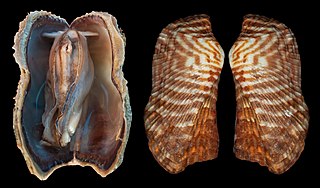
A cockle is an edible marine bivalve mollusc. Although many small edible bivalves are loosely called cockles, true cockles are species in the family Cardiidae.

Mactridae, common name the trough shells or duck clams, is a family of saltwater clams, marine bivalve mollusks in the order Venerida.

Limaria, the file shells or file clams, is a genus of marine bivalve molluscs in the family Limidae.

Glycymerididae, often misspelled as Glycymeridae, common names dog cockles or bittersweets, is a worldwide family of salt water clams, marine bivalve mollusks in the order Arcida. They are related to the ark clams. This family contains 45 extant species in four genera.

Corbulidae is a family of very small saltwater clams, marine bivalve molluscs in the order Myida.

The Semelidae are a family of saltwater clams, marine bivalve molluscs in the order Cardiida.

Spisula is a genus of medium-sized to large marine bivalve mollusks or clams in the subfamily Mactrinae of the family Mactridae, commonly known as surf clams or trough shells.

Corbula is a genus of very small saltwater clams, marine bivalve molluscs in the family Corbulidae, the basket clams.

Rangia is a genus of bivalve molluscs or clams in the subfamily Mactrinae of the family Mactridae.

Arca zebra, or the turkey wing ark clam, is a bivalve mollusc in the family Arcidae, the ark clams.

Arcinella cornuta, or the Florida spiny jewelbox clam or Florida spiny jewel box, is a marine species of bivalve mollusc in the family Chamidae. It can be found along the coast of North Carolina to Florida, Gulf of Mexico, Caribbean Central America, and Venezuela.

Glycymeris, common name the bittersweet clams, is a genus of saltwater clams, marine bivalve molluscs in the family Glycymerididae.

Hinge teeth are part of the anatomical structure of the inner surface of a bivalve shell, i.e. the shell of a bivalve mollusk. Bivalves by definition have two valves, which are joined together by a strong and flexible ligament situated on the hinge line at the dorsal edge of the shell. In life, the shell needs to be able to open slightly to allow the foot and siphons to protrude, and then close again, without the valves moving out of alignment with one another. To make this possible, in most cases the two valves are articulated using an arrangement of structures known as hinge teeth. Like the ligament, the hinge teeth are also situated along the hinge line of the shell, in most cases.

Glycymeris nummaria is a species of saltwater clam, a marine bivalve mollusc in the family Glycymerididae, the bittersweet clams.

Tucetona is a genus of saltwater clams, marine bivalve molluscs in the family Glycymerididae, the bittersweet clams. Unlike other genera in the family, Tucetona species have a ribbed shell.

Lucina is a genus of saltwater clams, marine bivalve molluscs.

Glycymeris yessoensis is a species of bivalve mollusc in the family Glycymerididae. It can be found burrowing in soft sediment in shallow water in the Pacific Ocean around the coasts of China and Japan. It is often associated with a polychaete worm with which it forms a commensal relationship.

Rangia cuneata or Atlantic rangia, also known as wedge clam, gulf wedge clam, common rangia, and cocktail clam, is a mollusc native to the Gulf of Mexico. It is an oval clam with a body length of up to 5cm, living from the intertidal zone to depths of 124 meters. It is edible and is harvested for food in Mexico, and has been so since pre-Hispanic times.

















